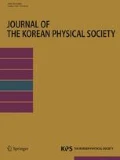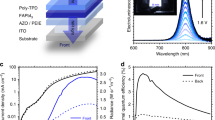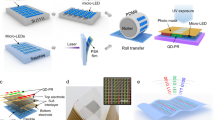Abstract
A transparent light emitting diode (LED) panel with a 16 × 16 multicolor LED array for a signage application is proposed and studied based on experimental and simulation results. As a transparent electrode, oxide/metal/oxide (OMO) trilayers with various Al interlayer thicknesses were fabricated and characterized using an established a simulation model. Using commercial ray tracing optical and SPICE simulation tools, we designed the LED panel and investigated in its optical and electrical properties. Moreover, in order to resolve the waveguide effect and voltage drop issue across the panel, we integrated additional optical structures and various OMO width into the design. The results show that the OMO electrode interconnects and proposed design considerations are pivotal aspects toward achieving transparent LED digital signage applications.
Similar content being viewed by others
Change history
11 August 2020
This paper was published with a typographical error in Acknowledgments on page 86. The grant number NRF-2019M3C1B909055 should read NRF-2019M3C1B9090559.
References
S. Sutthana, N. Hongsith and S. Choopun, Curr. Appl. Phys. 10, 813 (2010).
S. Song et al., Vacuum 85, 39 (2010).
R. D. Sahu, S. Lin and J. Huang, Appl. Surf. Sci. 253, 4886 (2007).
Y. Park, K. Choi, H. Kim and J. Kang, Electrochem. Solid-State Lett. 13, J39 (2010).
M. Bender et al., Thin Solid Films 326, 67 (1998).
M. Shakiba, A. Kosarian and E. Farshidi, J. Mater. Sci.: Mater. Electron. 28, 787 (2017).
R. D. Cairns et al., Appl. Phys. Lett. 76, 1425 (2000).
C. Li et al., Appl. Surf. Sci. 285, 505 (2013).
J. Kim et al., ACS Nano 5, 3222 (2011).
C. Liu and X. Yu, Nanoscale Res. Lett. 6, 75 (2011).
D. Leem et al., Adv. Mater. 23, 4371 (2011).
H. Park et al., Nano Lett. 14, 5148 (2014).
K. Kim et al., Nature 457, 706 (2009).
C. P. Chen et al., ACS Nano 4, 4403 (2010).
Y. Xia, L. Sun and J. Ouyang, Adv. Mater. 24, 2436 (2012).
W. Cao, Y. Li, E. Wrzesniewski and T. W. Hammond, Org. Electron. 13, 2221 (2012).
C. Guillen and J. Herrero, Thin Solid Films 520, 1 (2011).
W. Wei et al., J. Mater. Sci. Technol. 33, 1107 (2017).
J. Yu and S. Lee, Trans. Electr. Electron. Mater. 19, 212 (2018).
K. Choi et al., Appl. Phys. Lett. 92, 223302 (2008).
R. D. Sahu, S. Lin and J. Huang, Appl. Surf. Sci. 252, 7509 (2006).
M. Theuring, M. Vehse, K. von Maydell and C. Agert, Thin Solid Films 558, 294 (2014).
T. Winkler et al., Org. Electron. 12, 1612 (2011).
N. E. Cho, P. Moon, C. Kim and I. Yun, Expert Syst. Appl. 39, 8885 (2012).
K. Choi, J. Kim, Y. Lee and H. Kim, Thin Solid Films 341, 152 (1999).
H. Kim, K. Seo and H. Kim, Trans. Mater. Res. Soc. Jpn. 40, 401 (2015).
M. Girtan, Sol. Energy Mater. Sol. Cells 100, 153 (2012).
S. Lee, Y. Park and T. Seong, J. Alloys Compd. 776, 960 (2019).
S. Lee, E. Cho and S. Kwon, Appl. Surf. Sci. 487, 990 (2019).
C. Wu, RSC Adv. 8, 11862 (2018).
Synopsys Inc., CA, USA, HSPICE and RF Command Reference (2007).
Acknowledgments
This research was funded by the National Research Foundation of Korea (NRF-2019M3C1B909055), and partly supported by the Industy technology R&D program of MOTIE/KEIT (10063316, Development of core technology of tiling active matrix panel, aiming 200-inch UHD class display). The simulation tools were supported by the IDEC (IC Design Education Center) Program and CYFEM, Korea.
Author information
Authors and Affiliations
Corresponding authors
Rights and permissions
About this article
Cite this article
Park, J.Y., Jeon, H., Park, N. et al. Design of Transparent Multicolor LED Signage with an Oxide-Metal-Oxide Interconnect Electrode. J. Korean Phys. Soc. 77, 82–86 (2020). https://doi.org/10.3938/jkps.77.82
Received:
Revised:
Accepted:
Published:
Issue Date:
DOI: https://doi.org/10.3938/jkps.77.82




